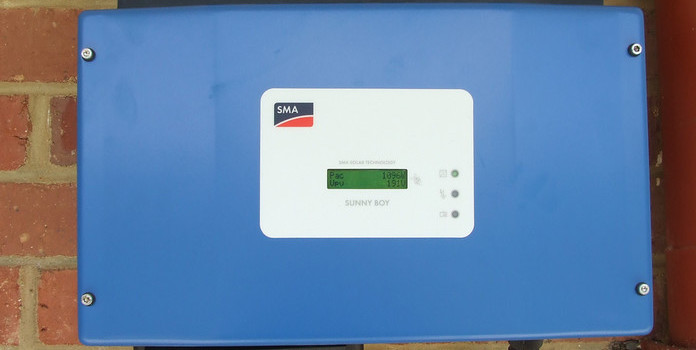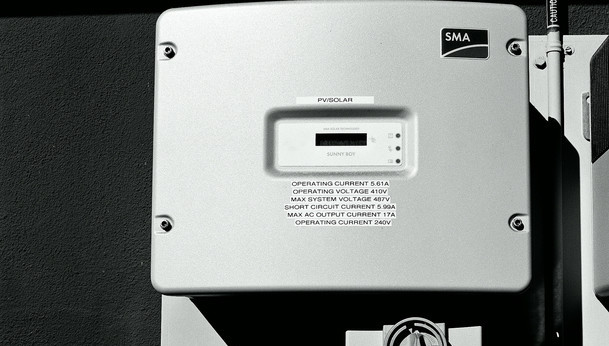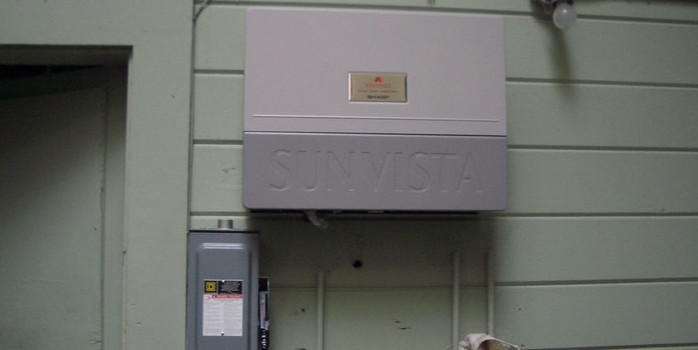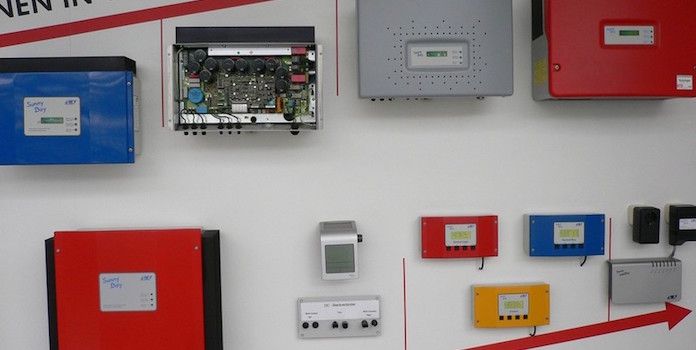Solar Inverter Efficiency – What is the Most Efficient Solar Inverter?
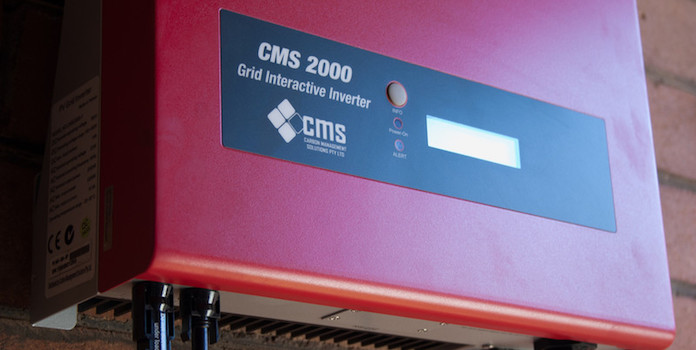
Comparing the expense of an efficient inverter against what it would save you in the long run
Solar inverter efficiency determines how well an inverter converts the DC electricity created by solar panels to AC electricity that can be used in our homes and by the grid. Inverters are an integral part of any solar installation. Without them, our installations would actually be useless, since we couldn’t use the electricity they produced.
No inverter is 100% efficient, as there will always be at least some loss of energy during the conversion process. However, inverters today enjoy very high efficiency, converting between 95% to 98% of all the DC electricity generated into AC, with manufacturers always reaching for that next step in performance.
Is solar inverter efficiency really that important? Is it worth spending a couple extra bucks for the most efficient solar inverter you can find? Let’s take a look at inverter efficiency to answer these questions and more!
Most efficient solar inverter
Let’s start off by naming the most efficient inverter we are aware of. As of September 2017, this distinction goes to SMA’s Sunny Boy inverter for larger residential installations (9kW to 11kW). These inverters see an incredibly high 98% efficiency (CEC rating, explained below), or 98.7% max rating.
Almost 99% efficiency? That’s pretty incredible. If you checked out that link above about performance, you know that this sort of efficiency is what inverter manufacturers were dreaming about just 2 years ago! These companies are willing to spend lots of time and money for only a 0.1% increase in efficiency, so SMA’s 98.7% efficiency is a pretty big breakthrough.
Of course, these larger inverters are only an option if your installation is around 9kW to 11kW in size – equal to about 34 to 42 average solar panels. If you have, like most of us, a much smaller solar installation (the average size is 5.6kW, according to research from the National Renewable Energy Lab, p.5), you’ll need a smaller inverter to match. SMA’s smaller offerings see a still-respectable, but lower, 96% to 97% efficiency.
SolarEdge’s inverters see an incredible 99% efficiency – higher than any other manufacturer – but come with a catch. The inverters must be coupled with the company’s module-level power optimizers — which see an efficiency of 98.8% — dropping the total efficiency of the entire inverter/optimizer system down to 97.8% efficient (which is actually still really, really good!) See below for details and links to product spec sheets.
Solar inverter efficiency from most popular manufacturers
In 2016, the National Renewable Energy Lab gathered stats (p.7) on the most commonly installed inverter manufacturers. The data only covers California, but other states likely see similar results.
Let’s take a look at moderate-sized inverters from each of these manufacturers to get an idea of common efficiency ratings. All efficiencies below are the CEC rating, a standardized testing protocol for inverter efficiency developed by the Sandia National Lab and adopted by the California Energy Commission.
- ABB PVI-5000/6000: 96% to 96.5% depending on size (spec sheet)
- Enphase IQ6 microinverter: 97% (spec sheet)
- SolarEdge Inverters: 99% (spec sheet), Power Optimizers: 98.8% (spec sheet) – For a grand total of 97.8% efficiency
- SMA Sunny Boy 3.0 – 7.7 Series: 96% to 97% depending on size (spec sheet)
- Fronius Primo UL: 95% (spec sheet) (Didn’t make NREL’s list, but still a popular option and included here for more context)
You can see that, among the most popular inverter manufacturers, efficiency hovers between 96% to 98%.
Compare these to smaller, cheaper inverters you hook up to your automobile or camper that see between 80% and 90% efficiency. They’re much less efficient and produce lower quality electricity that can’t support delicate electrical gadgets (pure sine vs modified sine) but are designed to be economical and for occasional use only.
Is inverter efficiency important?
Inverter efficiency directly affects your installation’s total energy production. All electricity your installation creates flows through the inverter. If your inverter is 80% efficient, you immediately lose 20% of all the electricity you created. If your inverter is 98% efficient, you lose only 2% of your electricity. It pays to pay attention to your inverter’s specs!
Over many years, that small inefficiency can add up. Let’s say your solar installation puts out 7,000 kilowatt-hours of electricity each year. After 25 years, it’ll have produced 175,000 kWh. Let’s see how much electricity you’d lose with different inverter efficiencies.
To make it more interesting, let’s turn this production into a monetary amount and say that each kWh is worth $0.13, the national average electricity price as of 2017. Let’s also say that those prices rise 2.6% each year – also the average yearly increase in the US.
At this rate, for our example:
- 100% efficient inverter: 175,000 kWh, $31,489 value (7000 kWh X $0.13 X 2.6% X 25 years)
- 98% efficient: 171,500 kWh, $30,859 value (loss of $630 compared to imaginary 100% efficient inverter)
- 96% efficient: 168,000 kWh, $30,229 value (loss of $1,260)
- 80% efficient: 140,000 kWh, $25,191 value (loss of $6,298)
Obviously, 100% efficient inverters don’t exist and you’d never install an 80% efficient inverter on a solar installation – both of those are there to provide greater context.
You can see that the difference between the 98% efficient inverter and 96% efficient inverter is only about $600 in losses – or $24 each year over those 25 years. While it’s still a loss of $600, it’s really not a huge amount when you consider how long it took to get there.
You want to squeeze out as much financial savings over the life of your solar installation as possible, so you need to make sure you’re not spending a premium on an ultra-efficient inverter that’ll never recoup its higher price. That more efficient inverter might produce an extra $600 of electricity, but if you spend an extra $1000 for it, does it really make sense?
Of course, there are other factors to consider when choosing an inverter (warranty, brand, etc), but if you’re spending an extra $2k on a premium inverter that is 2% more efficient, it might not be worth it.
To decide if a higher efficiency inverter is right for you, just walk through the steps above. Compare how much your solar installation would produce with your 2 different options and turn the kilowatt-hours produced by each into a monetary amount (check your utility bill for your own electricity cost). It never hurts to ask your installer for advice as well!
Other inverter considerations
Efficiency isn’t the only important consideration when purchasing an inverter. Here are a few others.
Cost
We’ve already mentioned this one, but we’ll put it here just to be thorough. You need to make sure that the power gains you see from increased efficiency are greater than the additional cost of the inverter.
Warranty
Solar salespeople rarely bring this up, but most inverters call it kaput after 12 to 15 years. It’ll likely be the first (and only) major solar component that you’ll need to replace. It might be worth a couple extra bucks to buy an inverter with a longer warranty, since inverters cost anywhere from $1,500 for a small system to thousands of dollars for a larger one.
Microinverter manufacturer Enphase warranties their products for a full 25 years – longer than any other manufacturer. While their microinverters see a lower efficiency and higher cost than others on this list, you can come out ahead financially when installing these, since you won’t have to purchase a replacement inverter down the road. Certainly keep things like this in mind when choosing an inverter!
Here’s the warranty length from the brands above:
- Enphase IQ6: 25 years
- SolarEdge: 25 years for the power optimizers, 12 years for the inverter
- ABB PVI 5000/6000: 10 years (p. 73)
- SMA Sunny Boy 3.0 to 7.7 US: 10 years
- Fronius: 2-year full warranty, after registration an additional 5 years parts warranty (service not included) or additional 3-year parts and service warranty.
Inverter size
You don’t want to buy the biggest inverter you can afford. You want to buy the inverter that fits the size of your installation – i.e. the number of solar panels installed. For example, if you have 30 panels each rated at 265 watts, you need an inverter that can handle an output of 7,950 watts (probably an inverter rated around 8kW). Any more than this is just money down the drain.
Since all the electricity your installation produces flows through the inverter, the efficiency of your inverter is, of course, an important consideration when choosing your equipment. You want to squeeze as much electricity (and financial savings) from your installation as possible and your inverter’s efficiency is certainly part of that.
Don’t forget, though, that you need to balance that efficiency with cost and other important inverter components – the warranty and installation size. In some cases, it might even make more financial sense to go with a lower efficiency inverter that has an extended warranty so you can avoid purchasing an entirely new inverter 15 years down the line. As always, do your homework and make sure your inverter is right for you before signing the dotted line!
What factors are most important to you when deciding on an inverter? Let us know in the comments!
Image Credits under CC License via Flickr – 1, 2, 3, 4 & Pixabay – 5

